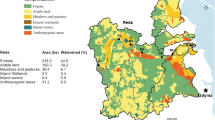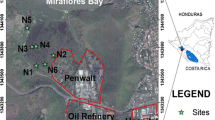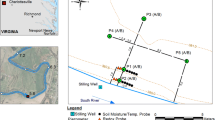Abstract
Purpose
Middle-European floodplain soils are often contaminated with mercury (Hg) and periodically flooded. In this study, the influence of a flooding event and subsequent dewatering on the volatilization of elemental Hg and methylated species was investigated in a laboratory experiment.
Material and methods
Undisturbed soil cores were taken from a topsoil (12.1 ± 0.75 mg kg−1 Hg) at the Elbe River in Lower Saxony, Germany. Soil columns were incubated at 20 °C with varying soil moisture (water-saturated for 2 weeks, 95 and 90 % water content for 1 week each), and the redox potential (EH) was recorded. The gaseous Hg that accumulated in the headspace of the flux chamber of the columns was pumped over cooled traps filled with adsorber material and analyzed by gas chromatography/inductively coupled plasma mass spectrometry for the various Hg species.
Results and discussion
The watering of the soil resulted in a rapid decrease in the EH and the achievement of strongly reducing conditions (EH < −100 mV). Mercury concentrations of the pore waters decreased continuously from 68.3 μg L−1 Hg at the beginning to 5.78 μg L−1 Hg at the end of the experiment. Species analyses revealed that exclusively elemental Hg volatilized. The volatilization rate was between 1.73 and 824 ng m−2 h−1 Hg, which is consistent with other studies at the Elbe River.
Conclusions
Even when flooded for a longer period of time, floodplain soils should show neither emission of methylated Hg nor exceptionally high volatilization of elemental Hg.




Similar content being viewed by others
References
Alberts JJ, Schindler JE, Miller RW, Nutter DE (1974) Elemental mercury evolution mediated by humic acid. Science 184:895–897
Allard B, Arsenie I (1991) Abiotic reduction of mercury by humic substances in aquatic system—an important process for the mercury cycle. Water Air Soil Pollut 56:457–464
Bahlmann E, Ebinghaus R, Ruck W (2006) Development and application of a laboratory flux measurement system (LFMS) for the investigation of the kinetics of mercury emissions from soils. J Environ Manag 81:114–125
Barkay T, Miller SM, Summers AO (2003) Bacterial mercury resistance from atoms to ecosystems. FEMS Microbiol Rev 23:355–384
Bartlett RJ, James BR (1993) Redox chemistry of soils. Adv Agron 50:151–208
Bloom NS, Preus E, Katon J, Hiltner M (2003) Selective extractions to assess the biogeochemically relevant fractionation of inorganic mercury in sediments and soils. Anal Chim Acta 479:233–248
Böhme F, Rinklebe J, Stark HJ, Mothes S, Neue HU (2005) A simple field method to determine mercury volatilization from soils. Environ Sci Pollut Res 12:133–135
Canario J, Branco V, Vale C (2007) Seasonal variation of monomethylmercury concentrations in surface sediments of the Tagus Estuary (Portugal). Environ Pollut 148:380–383
Choi H-D, Holsen TM (2009) Gaseous mercury emissions from unsterilized and sterilized soils: the effect of temperature and UV radiation. Environ Pollut 157:1673–1678
Cobos DR, Baker JM, Nater EA (2002) Conditional sampling for measuring mercury vapor fluxes. Atmos Environ 36:4309–4321
Costa M, Liss PS (1999) Photoreduction of mercury in sea water and its possible implications for Hg0 air-sea fluxes. Mar Chem 68:87–95
Costa M, Liss PS (2000) Photoreduction and evolution of mercury from seawater. Sci Total Environ 261:125–135
Counter SA, Buchanan LH (2004) Mercury exposure in children: a review. Toxicol Appl Pharmacol 198:209–230
Devai I, Patrick WH Jr, Neue H-U, DeLaune RD, Kongchum M, Rinklebe J (2005) Methyl mercury and heavy metal content in soils of rivers Saale and Elbe (Germany). Anal Lett 38:1037–1048
Du Laing G, Rinklebe J, Vandecasteele B, Meers E, Tack FMG (2009) Trace metal behaviour in estuarine and riverine floodplain soils and sediments: a review. Sci Total Environ 407:3972–3985
During A, Rinklebe J, Bohme F, Wennrich R, Stark HJ, Mothes S, Du Laing G, Schulz E, Neue H-U (2009) Mercury volatilization from three floodplain soils at the central Elbe River, Germany. Soil Sediment Contam 18:429–444
Fitzgerald WF, Lamborg CH, Hammerschmidt CR (2007) Marine biogeochemical cycling of mercury. Chem Rev 107:641–662
Fleming EJ, Mack EE, Green PG, Nelson DC (2006) Mercury methylation from unexpected sources: molybdate-inhibited freshwater sediments and an iron-reducing bacterium. Appl Environ Microbiol 72:457–464
Gilmour CC, Henry EA, Mitchell R (1992) Sulfate stimulation of mercury methylation in freshwater sediments. Environ Sci Technol 26:2281–2287
Gustin MS, Stamenkovic J (2005) Effect of watering and soil moisture on mercury emissions from soils. Biogeochemistry 76:215–232
GustinMS, EngleM, Ericksen J, Lyman S, Stamenkovic J, Xin M (2006) Mercury exchange between the atmosphere and low mercury con- taining substrates. Appl Geochem 21:1913–1923
Harmon SM, King JK, Gladden JB, Chandler GT, Newman LA (2004) Methylmercury formation in a wetland mesocosm amended with sulfate. Environ Sci Technol 38:650–656
Hintelmann H (2010) Organomercurials. Their formation and pathways in the environment. In: Sigel A, Sigel H, Sigel RKO (eds) Metal ions in life sciences, 7th edn. RSC Publishing, London
Hintelmann H, Wilken RD (1995) Levels of total mercury and methylmercury compounds in sediments of the polluted Elbe River - influence of seasonally and spatially varying environmental factors. Sci Total Environ 166:1–10
Hippler J, Kresimon J, Hirner AV (2004) Volatile mercury species in environmental gases and biological samples. In: Hirner AV, Emons H (eds) Organic metal and metalloid species in the environment: analysis, distribution, processes and toxicological evaluation. Springer, Berlin, pp 113–136
Hirner AV, Hippler J (2011) Trace metal(loid)s (As, Cd, Cu, Hg, Pb, PGE, Sb, and Zn) and their species. In: Wilderer P (ed) Treatise on water science (3). Elsevier, Oxford, pp 31–57
Jonsson S, Skyllberg U, Björn E (2010) Substantial emission of gaseous monomethylmercury from contaminated water-sediment microcosms. Environ Sci Technol 44:278–283
Kerin EJ, Gilmour CC, Roden E, Suzuki MT, Coates JD, Mason RP (2006) Mercury methylation by dissimilatory iron reducing bacteria. Appl Environ Microbiol 72:7919–7921
King JK, Kostka JE, Frischer ME, Saunders FM (2000) Sulfate-reducing bacteria methylate mercury at variable rates in pure culture and in marine sediments. Appl Environ Microbiol 66:2430–2437
Kocman D, Horvat M, Kotnik J (2004) Mercury formation in cantaminated soils from the Idrija mercury mine region. J Environ Monit 6:696–703
LABO (2003) Hintergrundwerte für anorganische und organische Stoffe in Böden. https://www.labo-deutschland.de/documents/LABO-HGW-Text_4e3.pdf. Accessed 22 July 2013
Li ZG, Feng X, Li P, Liang L, Tang SL, Wang SF, Fu XW, Qiu GL, Shang LH (2010) Emissions of air-borne mercury from five municipal solid waste landfills in Guiyang and Wuhan, China. Atmos Chem Phys 10:3353–3364
Lindberg SE, Zhang H, Gustin M, Vette A, Marsik F, Owens J, Casimir A, Ebinghaus R, Edwards G, Fitzgerald C, Kemp J, Kock HH, London J, Majewski M, Poissant L, Pilote M, Rasmussen P, Schaedlich F, Schneeberger D, Sommar J, Turner R, Wallschläger D, Xiao Z (1999) Increases in mercury emissions from desert soils in response to rainfall and irrigation. J Geophys Res 104:21879–21888
Liu G, Cabrera J, Allen M, Cai Y (2006) Mercury characterization in a soil sample collected nearby the DOE Oak Ridge Reservation utilizing sequential extraction and thermal desorption method. Sci Total Environ 369:384–392
Mansfeldt T (2003) In situ long-term redox potential measurements in a dyked marsh soil. J Plant Nutr Soil Sci 166:210–219
Mehra OP, Jackson ML (1960) Iron oxide removal from soils and clays by a dithionite-citrate system buffered with sodium bicarbonate. Clay Clay Miner 7:317–327
Morel FMM, Kraepiel AML, Amyot M (1998) The chemical cycle and bioaccumulation of mercury. Annu Rev Ecol Syst 29:543–566
Overesch M, Rinklebe J, Broll G, Neue H-U (2007) Metals and arsenic in soils and corresponding vegetation at Central Elbe river floodplains (Germany). Environ Pollut 145:800–812
Rinklebe J, During A, Overesch M, Wennrich R, Stark HJ, Mothes S, Neue H-U (2008) Optimization of a simple field method to determine mercury volatilization from soils—examples of 13 sites in floodplain ecosystems at the Elbe River (Germany). Ecol Eng 35:319–328
Rinklebe J, During A, Overesch M, Du Laing G, Wennrich R, Stärk H-J, Mothes S (2010) Dynamics of mercury fluxes and their controlling factors in large Hg-polluted floodplain areas. Environ Pollut 158:308–318
Rogers RD (1979) Volatility of Hg from soils amended with various Hg compounds. Soil Sci Soc Am J 43:289–291
Rogers RD, McFarlane JC (1979) Factors influencing the volatilization of mercury from soil. J Environ Qual 8:255–260
Schlüter K (2000) Review: evaporation of mercury from soils. An integration and synthesis of current knowledge. Environ Geol 39:249–271
Schwertmann U (1964) Differenzierung der Eisenoxide des Bodens durch photochemische Extraction mit saurer Ammoniumoxalatlösung. Z Pflanzenernaehr Düng Bodenkd 105:194–202
Shi J, Liang L, Jiang G, Jin X (2005) The speciation and bioavailability of mercury in sediments of Haihe River, China. Environ Int 31:357–365
Song X, Van Heyst B (2005) Volatilization of mercury from soils in response to simulated precipitation. Atmos Environ 39:7494–7505
Wallschläger D, Hintelmann H, Evans RD, Wilken RD (1995) Volatilization of dimethylmercury and elemental mercury from river Elbe floodplain soils. Water Air Soil Pollut 80:1325–1329
Wallschläger D, Desai MVM, Wilken R-D (1996) The role of humic substances in the aqueous mobilization of mercury from contaminated floodplain soils. Water Air Soil Pollut 90:507–520
Wallschläger D, Kock HH, Schroeder WH, Lindberg SE, Ebinghaus R, Wilken RD (2000) Mechanism and significance of mercury volatilization from contaminated floodplains of the German River Elbe. Atmos Environ 34:3745–3755
Wallschläger D, Kock HH, Schroeder WH, Lindberg SE, Ebinghaus R, Wilken RD (2002) Estimating gaseous mercury emissions from contaminated floodplain soils to the atmosphere with simple field measurement techniques. Water Air Soil Pollut 135:39–54
Warner KA, Roden EE, Bonzongo J-C (2003) Microbial mercury transformation in anoxic freshwater sediments under iron-reducing and other electron-accepting conditions. Environ Sci Technol 37:2159–2165
Wasserman JC, Amouroux D, Wasserman MAV, Donard OFX (2002) Mercury speciation in sediments of a tropical coastal environment. Environ Technol 23:899–910
WRB, IUSS Working Group (2006) World reference base for soil resources. a framework for international classification, correlation and communication. World soil resources reports 103. FAO, Rome
Yu X, Li H, Pan K, Yan Y, Wang WX (2012) Mercury distributionm speciation and bioavalability in sediments from the Pearl River Estuary, Southern China. Mar Pollut Bull 64:1699–1704
Zhang H, Lindberg SE (1999) Processes influencing the emission of mercury from soils: a conceptual model. J Geophys Res 104:21889–21896
Zhi-Guang L (1985) Oxidation-reduction potential. In: Tian-ren Y (ed) Physical chemistry of paddy soils, 1st edn. Springer, Berlin, pp 1–26
Acknowledgments
This research was supported by the German Research Foundation (DFG) under the contract no. Ma 2143/9-1 and the RheinEnergieStiftung under the contract no. W-09-2-018.
Author information
Authors and Affiliations
Corresponding author
Additional information
Responsible editor: Jianming Xu
Rights and permissions
About this article
Cite this article
Hindersmann, I., Hippler, J., Hirner, A.V. et al. Mercury volatilization from a floodplain soil during a simulated flooding event. J Soils Sediments 14, 1549–1558 (2014). https://doi.org/10.1007/s11368-014-0908-2
Received:
Accepted:
Published:
Issue Date:
DOI: https://doi.org/10.1007/s11368-014-0908-2




